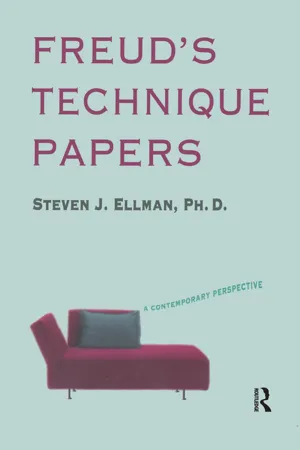Psychology
Freud Wolfman Study
The Freud Wolfman Study refers to Sigmund Freud's famous case study of a patient known as the "Wolf Man." This study is a significant contribution to psychoanalytic theory and clinical practice, as it provided insights into the treatment of neuroses and the interpretation of dreams. The case study focused on the patient's childhood experiences and their impact on his psychological development and symptoms.
Written by Perlego with AI-assistance
Related key terms
7 Key excerpts on "Freud Wolfman Study"
- eBook - ePub
- Jeffrey Berman(Author)
- 2022(Publication Date)
- Bloomsbury Academic(Publisher)
Chapter 2The Wolf-Man
Memoirs“I, who am now a Russian émigré, eighty-three years of age, and who was one of Freud’s early psychoanalytic patients, known as ‘The Wolf-Man,’ am sitting down to write my recollections of my childhood” (4). Thus begins the most extraordinary case study in psychoanalytic history, all the more singular because of the patient’s arresting pseudonym. The ghost of Sigmund Freud must have been beaming when he read the Wolf-Man’s Memoirs, for one cannot imagine a more idealized account of psychoanalysis.We now know that the Wolf-Man’s real name was Sergei Pankejeff. Most scholars continue to refer to him by Freud’s pseudonym, as I will. Born on January 6, 1887, to a wealthy land-owning St. Petersburg family, he remains Freud’s most iconic case, the only patient we can follow from infancy to death in 1979 at age ninety-two. The cover of the paperback edition of The Wolf-Man by the Wolf-Man characterizes the Memoirs as the “double story of Freud’s most famous case,” but this is an understatement. We have several counterstories of the same patient, each with its own insights and blind spots: Freud’s From the History of an Infantile Neurosis, written in 1914 but not published until 1918; the Wolf-Man’s Memoirs, edited and translated by the psychoanalyst Muriel Gardiner, published in 1971; Ruth Mack Brunswick’s “A Supplement to Freud’s ‘History of an Infantile Neurosis,’” first published in 1928 and then included in Gardiner’s 1971 volume; Muriel Gardiner’s impressions of her meetings and correspondence with the Wolf-Man; and the Viennese journalist Karin Obholzer’s startlingly candid book The Wolf-Man: Conversations with Freud’s Patient—Sixty Years Later - eBook - ePub
Reading Freud's Patients
Memoir, Narrative and the Analysand
- Anat Tzur Mahalel(Author)
- 2020(Publication Date)
- Routledge(Publisher)
Glückshaube (German for “caul,” literally a “lucky hood”). The veil is represented as an ambivalent object both for Freud and for Pankejeff, who are enticed by the sense of a final truth behind the veil yet constantly doubt the possibility of grasping it. For Freud, psychoanalysis is the very process of lifting the veil, yet his analysand remained for him an unsolved riddle. Pankejeff, in a volume dedicated to the story of the Wolf Man, created an autobiographical text that deliberately avoids telling the story of the analysand, thus drawing a veil over his story. The paradox embodied in lifting the veil is discussed in relation to Walter Benjamin’s distinction between materiality and truth and his notion of the inherent unity of the veil and the veiled.The Wolf Man’s case occupied Freud his entire writing life and continued to occupy psychoanalytic literature throughout the years to an unprecedented degree. From the History of an Infantile Neurosis was the last case study Freud wrote and one of the most detailed. Not only the case study but also the patient himself who was known as the Wolf Man occupied the psychoanalytic community throughout the years (Abraham and Torok 1986 [1976]; Brooks 1984; Loughman 1984; Mahony 1984; Offenkrantz 1973; Werbert 1998). Ongoing interest in the Wolf Man has produced new examinations of his pathology and the analytic work with Freud, as well as new interpretations of works about him. This continuous interest can be explained by the obscurities and contradictions surrounding his character. In the concluding remarks of the case study, Freud discusses the Wolf Man’s complexity and resistance to interpretation as a riddle as-yet-unsolved: “Personal peculiarities in the patient and a national character that was foreign to ours made the task of feeling one’s way into his mind a laborious one” (Freud 1918, 104).A bond was forged between Freud’s text and the subject who was given a pseudonym in that text, a person who became a persona and lived his adult life with the dual identity of Russian émigré and the subject of Freud’s famous case. Approximately five decades after Freud’s case study appeared, the patient at its center published a memoir telling his life story and a separate essay offering recollections of his analytic encounter with Freud. The two pieces (Pankejeff 1971a, 1971b) were first published in English and German in 1971 in a volume edited by the American psychoanalyst Muriel Gardiner. In addition to the texts written by the Wolf Man, the volume also reprints Freud’s famous case study about him; an additional case study written by the analyst Ruth Mack Brunswick, originally published in 1928 (Mack Brunswick 1928); the editor’s own recollections of the Wolf Man, based on their long relationship; a selection of Pankejeff’s letters to her; and her diagnostic impression of his personality. Thus, the texts collected in this volume were written by four different authors at various times. Freud first published his case study after World War I, approximately five years after the analysis ended. Mack Brunswick published her paper about a year after the Wolf Man’s second analysis ended. Gardiner published her own recollections of the famous patient in various journals from the 1950 until the book was published. - eBook - ePub
- Barbara Creed(Author)
- 2015(Publication Date)
- Melbourne University Press Digital(Publisher)
10 The key figures in the patient’s life were his parents (with whom he had infrequent contact), his sister, his beloved Nanya, various governesses, servants and relatives. He believed initially that his own neurosis was a result of an hereditary flaw that had afflicted other family members, primarily on his father’s side. His mother suffered from a range of illnesses, his father was diagnosed as a manic-depressive, and his paternal uncle was believed to suffer from obsessional neurosis. In addition, his grandmother and father were both thought to have committed suicide. His sister, Anna, committed suicide as a young woman by drinking mercury while travelling away from home.The Wolf Man entered into therapy with Freud because of ill health, severe depression and an inability to function at all in daily life. Freud turned to the Wolf Mans childhood to explain the origins of his psychological problems, specifically his infantile neurosis which included a wolf phobia and his castration anxiety. Freud explained that his account would ‘deal with an infantile neurosis which was analysed not while it actually existed, but only fifteen years after its termination’.11 He argued that ‘analyses of children’s neuroses’ are of ‘high theoretical interest’ because of the assistance they offer in coming to ‘a proper understanding of the neuroses of adults’.12THE WOLF MAN’S NIGHTMAREFreud interpreted the little boy’s wolf nightmare, which occurred when he was four years of age, as the boy’s recollection or interpretation of the primal scene of parental sex. The Wolf Man’s dream, which drew heavily on fairy tales, focused on the figure of the wolf—the creature whose image in a storybook had previously been used by his sister to terrify him. The Wolf Man was lying in bed at night and dreamt that it was a winter’s night; suddenly ‘the window opened of its own accord’ and he became terrified to see that six or seven white wolves were sitting in the branches of a big walnut tree outside the window: - eBook - ePub
- Muriel Gardiner(Author)
- 2018(Publication Date)
- Routledge(Publisher)
Part II Psychoanalysis and the Wolf-Man My Recollections of Sigmund Freud by Wolf Man I first met Freud in the year 1910. At that time psychoanalysis and the name of its founder were practically unknown beyond the borders of Austria. Before I report on how I came into analysis with Freud, however, I should like to recall to you the desolate situation in which a neurotic found himself at that period before psychoanalysis. A sufferer from neurosis is trying to find his way back into normal life, as he has come into conflict with his environment and then lost contact with it. His emotional life has become “inadequate,’ ‘inappropriate to outer reality. His goal is not a real known object, but rather some other object, hidden in his unconscious, unknown to himself. His affect by-passes the real object, accessible to his consciousness. As long as nothing was known of this state of affairs, only two explanations were possible: one, that of the layman, concerned itself with the increase in intensity of affect, which was out of proportion to the real situation; it was said that the neurotic exaggerated everything. The other explanation, that of the neurologist or psychiatrist, derived the mental and emotional from the physical, and sought to persuade the patient that his trouble was due to a functional disorder of the nervous system. The neurotic went to a physician with the wish to pour out his heart to him, and was bitterly disappointed when the physician would scarcely listen to the problems which so troubled him, much less try to understand them. But that which to the doctor was only an unimportant by-product of a serious objective condition was for the neurotic himself a profound inner experience. So there could be no real contact between patient and physician - eBook - ePub
Freud's Technique Papers
A Contemporary Perspective
- Steven J. Ellman(Author)
- 2018(Publication Date)
- Routledge(Publisher)
In discussing Freud's cases it is hard to restrict ourselves to his own writings in view of the vast amount of material that has been written by others about Freud's patients. For example, the literature about the Wolf Man, Freud's most famous case report, includes many accounts of his adult life, his childhood, and information about his subsequent treatments, as well as memoirs by the Wolf Man himself. Although the Wolf Man was certainly Freud's most scrutinized patient, all of Freud's patients have elicited a good deal of inquiry into their life circumstances. It is inevitable that there have been many attempts at modern interpretations of all the case material (Blum 1980b, Gardiner 1971, Kanzer 1980a,b, Langs 1980). Given this additional commentary, we will wander back and forth between Freud's statements and some of the modern interpretations. Hopefully, this oscillating will improve our vision as we look at the patients and the treatment that Freud immortalized in these now classic formulations.The question arises as to how to approach Freud's case material. The cases typically considered to be Freud's major ones start from Dora7 and end with the Wolf Man.8 Between the publication of these cases, Freud wrote about Little Hans,9 the Rat Man,10 and Schreber.11 Little Hans, a child at the time of treatment, was treated by his father, who was supervised by Freud. The Schreber case was an analysis by Freud of Schreber's memoirs. Since Freud did not directly treat either Little Hans or Schreber, we will not discuss these cases in this chapter. We will focus mainly on the case of the Rat Man, since it is in this case that we can most clearly see Freud in action. In addition, we will again briefly discuss some aspects of Dora and the Wolf Man.The Analytic Community and Freud's Cases
It is a sign of Freud's dominating presence in psychoanalysis that Blum wrote in 1980: "When I was a candidate, the case (of the Wolf Man) was taught with almost unquestioned acceptance of Freud's formulations and adherence to his established early views (1914) and those of Brunswick (1928)" (Blum 1980, p. 342).This statement is quite remarkable in its implications tor psychoanalytic education. The Wolf Man was seen in treatment from 1910 to 1914. Freud himself anticipated that his explanation of the Wolf Man's childhood (with respect to a dream of the Wolf Man) would not be universally accepted by other psychoanalysts. He acknowledged that his interpretations of a dream of the Wolf Man were debatable. It is an exceptional circumstance that what Freud knew to be controversial in 1914 was accepted without question thirty to forty years later. This condition of analytic education is now (hopefully) a thing of the past. Blum's recollection is illustrative of a condition of public acceptance of Freud's ideas even though many analysts had private reservations about Freud's conclusions. This accounts for a certain type of conformity in the early literature concerning these cases; this conformity too is now relegated to the past. - eBook - ePub
Elizabeth Severn
The "Evil Genius" of Psychoanalysis
- Arnold Rachman(Author)
- 2017(Publication Date)
- Routledge(Publisher)
At the same time Ferenczi was influenced by Freud’s cases, Freud was influenced by Ferenczi’s cases of “Observations on larval forms of onanism” (Ferenczi, 1980c) and “Further development of the active therapy” (Ferenczi, 1980e), in which Ferenczi was creating active techniques to treat analysands who had difficulty free associating and adhering to the basic rules of psychoanalysis. Ferenczi paid tribute to Freud when he made it clear his teacher was the inspiration for his original clinical experiments (Ferenczi, 1980d). Freud acknowledged this credit (Freud, 1995b).Sergei Pankejeff (the Wolf Man) as Freud’s difficult analysandSergei Pankejeff (December 24, 1886 – May 7, 1979) was a Russian aristocrat from Odessa. Freud gave him the pseudonym of the Wolf Man to protect his identity, using a dramatic dream he had about wolves as the pseudonym. The dream of wolves will be discussed in detail in the section to come. Pankejeff was sent to Freud by his physician on the basis of three serious symptoms:1. An inability to have bowel movements without an enema.2. Debilitating depression.3. The feeling there was a veil cutting him off from the world.Before seeing Freud, Pankejeff suffered from depression in 1907 and went to Munich, saw many doctors, and stayed at many psychiatric hospitals between February 1910 and July 1914. He had a brief psychoanalysis with Freud in 1919. According to Freud, Pankejeff was not open to a full analysis until he set a termination date for the analysis, which was one year after the commencement of analysis. The setting of a date for termination was one of the non-interpretative measures Freud introduced in the analysis (Gardner, 1971).Freud’s analysis of Pankejeff centered on the interpretation of a dream of wolves, which he recalled in the analysis as an adult; the actual event occurred when he was five years old. The dream interpretation that Freud offered centered on Pankejeff witnessing a primal scene, i.e. his parents having sex from behind, doggy style. Later on in Freud’s interpretation he changed his idea to Pankejeff having witnessed animals copulating, which was displaced to his parents. In order to discuss this difficult case the dream of wolves will be reproduced:“IV: The Dream and the Primal Scene”I dreamt that it was night and that I was lying hung in my bed. My bed stood with its foot towards the window; in front of the window there was a row of old walnut trees. I knew it was winter when I had the dream, and night-time. Suddenly the window opened of its own accord, and I was terrified to see that some white wolves were sitting on the big walnut tree in front of the window. There were six or seven of them. The wolves were quite white and looked more than foxes or sheep-dogs, for they had big tails like foxes and they had their ears pricked like dogs when they paid attention to something. In great terror, evidently of being eaten up by the wolves, I screamed and woke up. - eBook - ePub
The Analytical Process
Journeys and Pathways
- Thierry Bokanowski(Author)
- 2018(Publication Date)
- Routledge(Publisher)
Chapter Fourteen A historical example of negativising transference: the “young Russian” known as “the Wolf Man”“At that time I had taken on the case of a young Russian, a man spoilt by wealth, who had come to Vienna in a state of complete helplessness, accompanied by a private doctor and an attendant. In the course of the few years it was possible to give him back a large amount of his independence, to awaken his interest in life and to adjust his relation to the people most important to him. But there progress came to a stop”(Freud, 1937c, p. 217)We are nowadays in a position to assert that his treatment of “the Wolf Man” (1918b) marked an epistemic break in Freud’s system with regard to the concepts of infantile neurosis and transference neurosis, and the way he developed them, due, among other factors, to the vicissitudes of the negativising (destructive) transference that occurred. It would appear that the numerous advances Freud made before and after this treatment and that are now referred to as the “1920s turning point” stem directly from the theoretical and practical difficulties he encountered.26We can now understand what these difficulties were about when we read the Wolf Man’s memories in the interview he gave to Obholzer:What ultimately has been explained by dreams in my history? I’m not sure. Freud relates everything to the primal scene that he derives from the dream. But that scene does not occur in the dream. When he interprets the white wolves as nighshirts or something like that, for example, linen sheets or clothes, that is somehow far-fetched, I think. That scene in the dream with the windows open and so on and the wolves are sitting there, and his interpretation, I don’t know – I find it very far-fetched. (Obholzer, 1982, p. 35)
Index pages curate the most relevant extracts from our library of academic textbooks. They’ve been created using an in-house natural language model (NLM), each adding context and meaning to key research topics.






